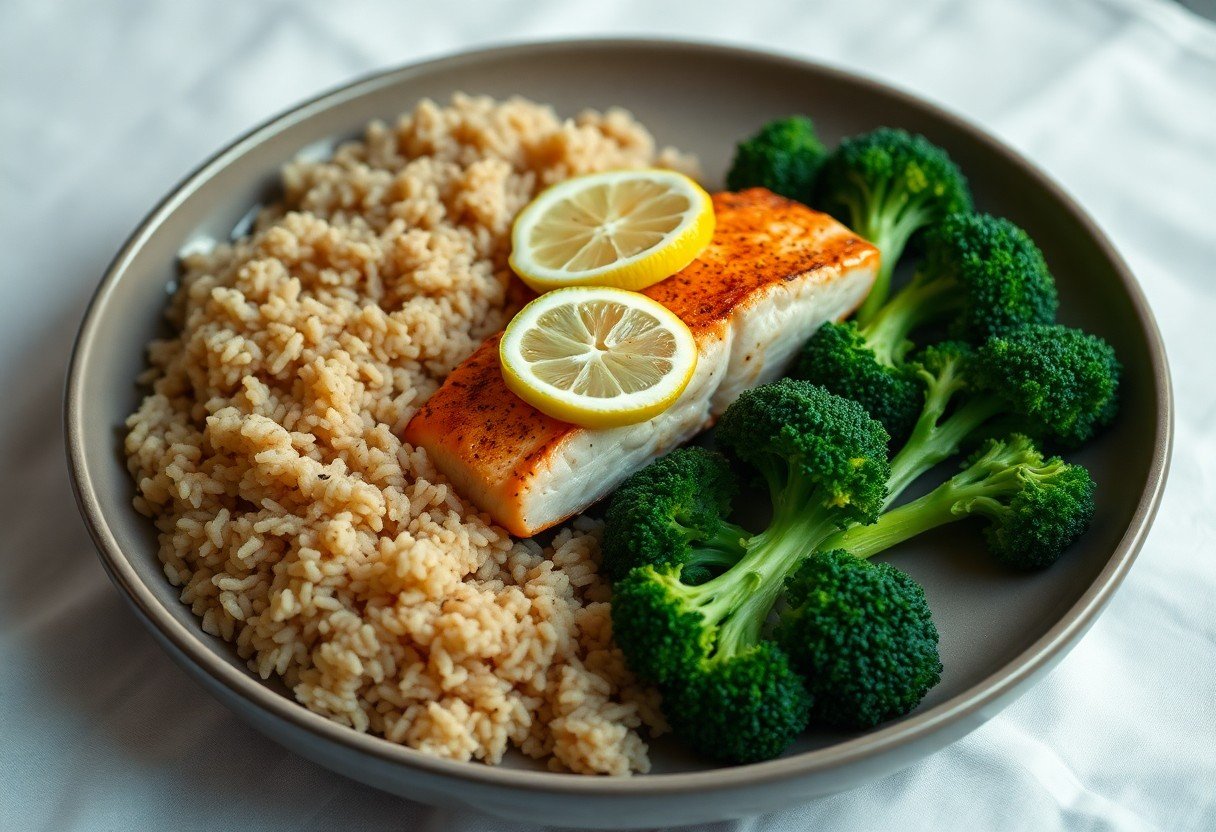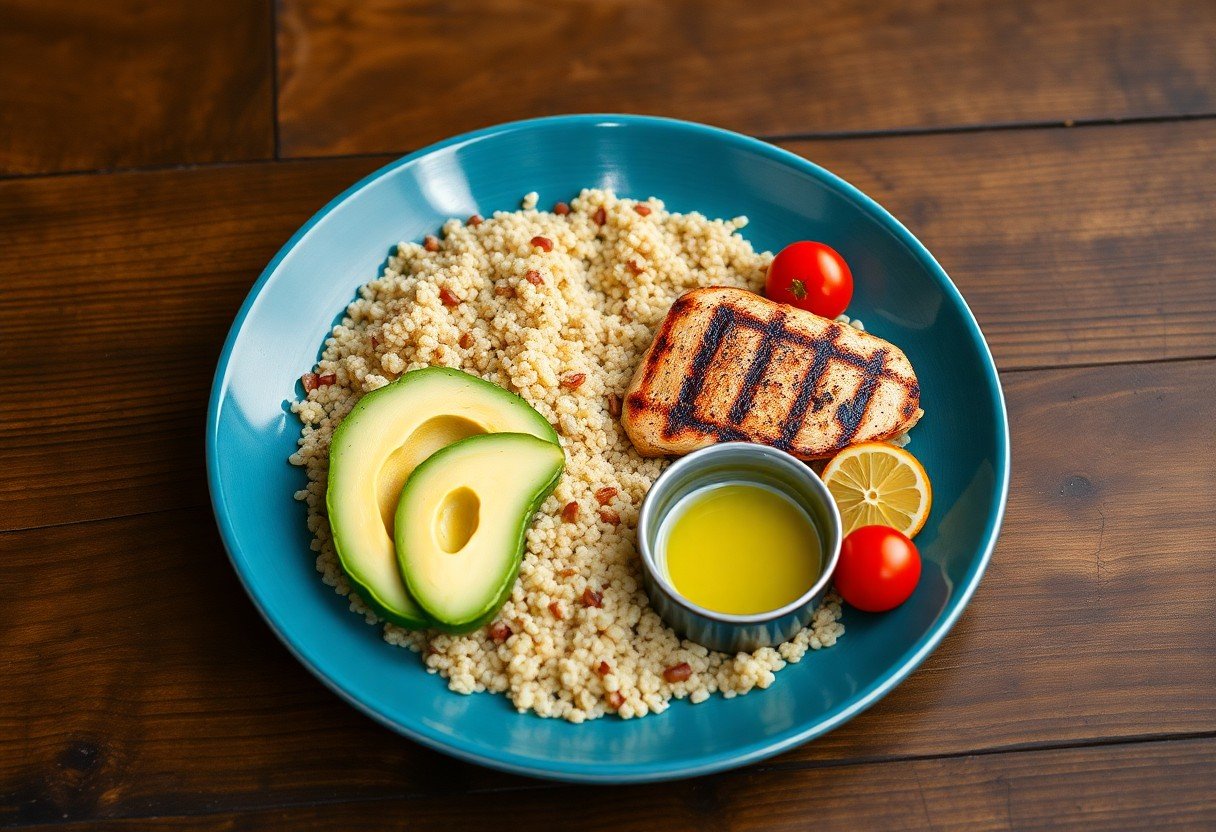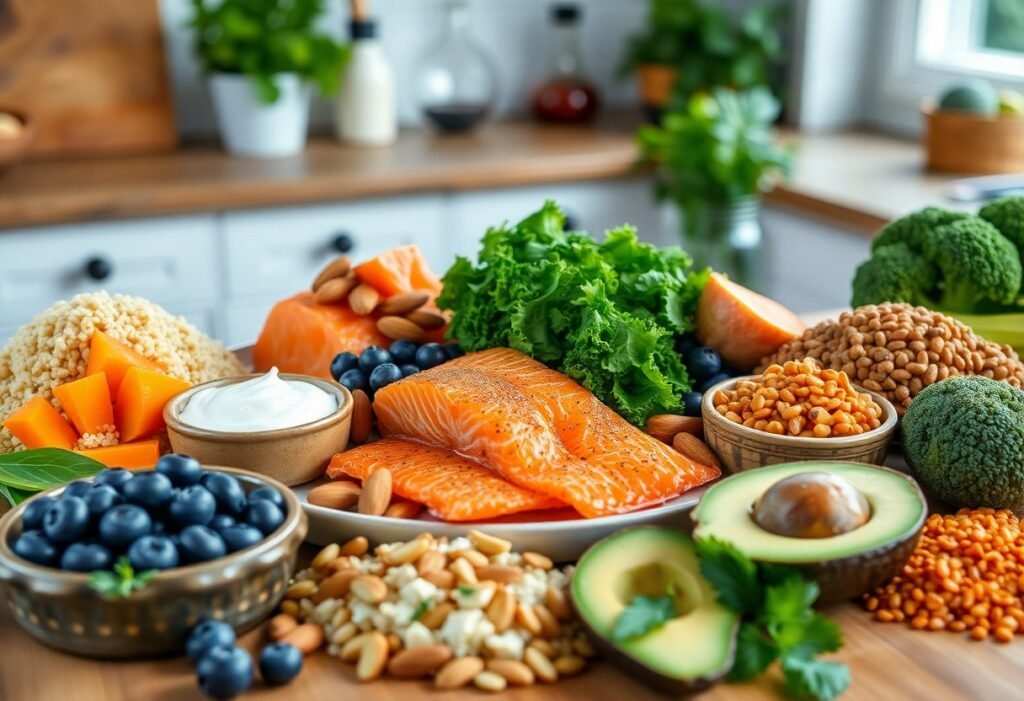Just as every meal sets the tone for your day, balancing your plate with the right mix of carbs, protein, and fats is vital for your overall health and energy levels. Understanding how each macronutrient benefits you can help you make informed choices that support your wellness goals. By learning to properly portion these nutrients, you can create satisfying meals that keep you feeling full and energized throughout the day.

Key Takeaways:
- Include a variety of carbohydrates, proteins, and healthy fats for a balanced meal.
- Opt for whole grains, lean proteins, and sources of unsaturated fats.
- Balance portion sizes to maintain energy levels and support overall health.
Understanding Macronutrients
What are Carbohydrates?
Carbohydrates are the body’s primary source of energy, playing a vital role in fueling your daily activities. They are broken down into glucose, which your cells use for immediate energy or store for later use. A well-rounded diet should include various types of carbs to help maintain your energy levels.
Types of Carbohydrates
There are two main types of carbohydrates: simple and complex carbohydrates. Simple carbohydrates, found in foods like sugar and fruit, are quickly digested and can provide a rapid energy boost. In contrast, complex carbohydrates, present in whole grains and vegetables, digest more slowly, offering lasting energy.
- Simple Carbohydrates
- Complex Carbohydrates
- Fiber
- Glycemic Index
- Whole Grains
| Type | Example |
| Simple | Sugar |
| Complex | Whole grains |
| Fiber | Vegetables |
| Glycemic Index | White bread |
| Whole Grains | Brown rice |
Understanding carbohydrate types helps you make informed dietary choices. Prioritize whole grains and vegetables, which enhance your nutrient intake and provide sustained energy levels. After balancing your carbs, consider how protein fits into your meals.
What is Protein?
Protein serves as the building block for your body’s cells, muscles, and tissues. It is crucial for growth, repair, and maintaining a healthy immune system. Regular intake of protein helps you feel full, supports muscle mass, and aids in weight management.
Protein consists of amino acids, which your body needs to function effectively. Including a variety of protein sources ensures all crucial amino acids are consumed. Aim for a mix of animal and plant-based proteins to meet your nutritional needs, enhancing muscle recovery and overall health.
Different Sources of Protein
Protein can come from both animal and plant-based sources. Meat, fish, dairy, eggs, legumes, nuts, and seeds are all rich in protein. By including a diverse range of sources, you not only get different flavors and textures in your meals but also a broad spectrum of nutrients.
Striking a balance between animal and plant proteins can provide complex nutrients while supporting your individual dietary lifestyle. Animal proteins often contain crucial vitamins, while plant-based proteins contribute fiber. After evaluating your protein sources, turn to fats.
Understanding Fats
Fats are an crucial nutrient that supports brain health, hormone production, and energy storage. They can be categorized into different types, each impacting your health in various ways. It’s crucial to focus on healthy fats, as they contribute to overall well-being.
Incorporating healthy fats into your diet helps with nutrient absorption and provides a sense of fullness. Focus on sources like avocados, nuts, and olive oil, which contain beneficial fatty acids. By prioritizing quality fats over unhealthy trans fats, you can optimize your diet.
Types of Fats
Fats can be classified into three main categories: saturated, unsaturated, and trans fats. Unsaturated fats, found in foods like nuts and fish, are generally healthier. Saturated fats, prevalent in animal products, should be limited, while trans fats pose health risks and should be avoided.
- Saturated Fats
- Unsaturated Fats
- Trans Fats
- Omega-3 Fatty Acids
- Heart Health
| Type | Source |
| Saturated | Butter |
| Unsaturated | Olive oil |
| Trans | Processed foods |
| Omega-3 | Fish |
| Heart Health | Nuts |
Awareness of fat types helps you make healthier dietary choices and supports your overall well-being. Assume that by selecting quality fats, you’re investing in a healthier lifestyle. After understanding fats, consider how all these macronutrients fit together on your plate for a balanced meal.
The Balanced Plate Concept
Importance of Balance
A balanced plate ensures you get the right nutrients to support your overall health and energy levels. Excess or deficiency in any macronutrient can lead to health issues, including fatigue, muscle loss, and metabolic disorders. Striving for balance helps promote a sustainable approach to eating that can be maintained long-term.
Ideal Plate Proportions
Your plate should consist of about 50% carbohydrates, 25% protein, and 25% healthy fats. These proportions provide a well-rounded source of energy and nutrients that promote satiety and optimal bodily function.
Focusing on these ideal proportions allows you to create meals that not only satisfy your hunger but also fuel your body efficiently. When constructing your meal, consider filling half your plate with colorful vegetables and whole grains for carbohydrates, adding a lean protein source like chicken or beans, and including healthy fats such as avocado or olive oil. This approach promotes better digestion, nutrient absorption, and overall health.
Visualizing Your Plate
To effectively implement the balanced plate concept, visualize your plate divided into sections. This simple mental model helps you achieve the desired proportions at every meal.
Imagine your plate as a canvas divided into four parts: half for vegetables and whole grains, one-quarter for protein, and one-quarter for healthy fats. You can even use physical dividers or small portion plates to aid in visualization. This technique keeps your meals colorful and diverse, enhancing not only nutritional content but also your enjoyment of food. Regularly applying this visualization can make achieving balance both intuitive and manageable.

How to Build a Balanced Plate
Step-by-Step Guide to Building Your Plate
To create a balanced plate, start by dividing it into sections. Allocate half the plate for vegetables and fruits, one quarter for lean protein, and the remaining quarter for healthy carbohydrates. Use this visual guide to ensure you’re getting a variety of nutrients to support your overall health.
| Vegetables & Fruits | Fill half your plate with a mix of colorful, nutrient-dense options. |
| Lean Protein | Choose sources like chicken, fish, tofu, or legumes. |
| Healthy Carbohydrates | Incorporate whole grains or starchy vegetables. |
Tips for Choosing Healthy Carbs
Selecting healthy carbs involves focusing on whole, unprocessed sources that provide fiber and vital nutrients. Opt for options like whole grains, beans, fruits, and vegetables, which can enhance your digestive health and stabilize blood sugar. Prioritize whole foods over refined products to maintain energy levels and overall well-being.
- Whole grains such as brown rice and quinoa.
- Fruits that are high in fiber, like berries and apples.
- Vegetables that provide vitamins and minerals.
Recognizing the importance of fiber in your diet is key to digestive health. Foods rich in fiber help regulate your blood sugar levels and support heart health. By incorporating foods like legumes and including diverse vegetables, you can enhance the nutritional value of your meals.
- Whole foods for better nutrition.
- Variety of starches for comprehensive benefits.
- Fiber-rich foods for digestive health.
Recognizing the benefits of consuming different carbohydrates allows you to enjoy better mental clarity and sustained energy throughout the day. Focus on making informed choices within your meal prep to incorporate these healthy options.
Tips for Selecting Quality Proteins
When opting for proteins, aim for lean sources that promote muscle health and maintain satiety. Prioritize options like fish, poultry, legumes, and low-fat dairy to ensure that you are getting the necessary amino acids. Avoid processed meats high in sodium and unhealthy fats for optimal health.
- Lean meats such as chicken and turkey.
- Fish rich in Omega-3 fatty acids, like salmon.
- Plant-based proteins such as lentils and chickpeas.
Knowing the sources of protein you consume is important for muscle repair and growth. Incorporating a mix of plant-based and animal proteins expands your nutrient intake, ensuring your body receives the variety it needs for optimal function.
- Protein combinations for complete amino acids.
- Balance between different protein types.
- Moderation in meat choices for better health.
Knowing how to balance your protein choices will help you fuel your body effectively and support overall wellness. Integrating diverse protein sources into your meals can also enhance flavor and satisfaction.
Tips for Incorporating Healthy Fats
Incorporate healthy fats by choosing unsaturated options such as avocados, nuts, seeds, and olive oil. These fats support heart health and can enhance the absorption of fat-soluble vitamins. Limit saturated fats and avoid trans fats to maintain cardiovascular health.
- Avocados for creamy texture and healthy fats.
- Nuts and seeds as snack options.
- Olive oil for cooking and dressings.
Any fat you include should contribute to your overall dietary goals. Using a variety of healthy fats can not only provide vital fatty acids but also add rich flavors to your meals. Focus on moderation to ensure healthy choices benefit your diet.
- Variety of healthy fat sources for better health.
- Cooking methods that preserve nutrients.
- Mindful consumption of fats daily.
Any time you select fats, remember that quality matters. Choosing high-quality fats will support your overall health, contributing benefits for brain function and sustained energy throughout the day.
Factors to Consider
- Individual dietary needs: Consider specific health conditions, food allergies, or sensitivities.
- Activity level: Align your meal composition with your physical activity and energy expenditure.
- Food preferences: Incorporate foods you enjoy while adhering to nutritional guidelines.
- Availability of ingredients: Utilize seasonal and local produce for freshness and cost-effectiveness.
Any meal plan should take these factors into account for optimal nourishment while promoting sustainability.
Individual Dietary Needs
Your unique health profile may dictate food choices. If you have conditions such as diabetes, hypertension, or allergies, you must select foods that complement your situation. Consulting a healthcare professional can help tailor a diet that aligns with your nutritional requirements.
Activity Level and Energy Requirements
Your energy needs increase with higher physical activity levels. A more active lifestyle means you will require a greater proportion of carbohydrates for energy, alongside adequate protein for muscle recovery. Understanding this balance is imperative for fueling your workouts and daily activities effectively.
For instance, a person engaging in high-intensity sports may need around 6-10 grams of carbohydrates per kilogram of body weight, while a sedentary individual may thrive on much less, perhaps 3-5 grams. Monitoring your energy levels and adjusting your macronutrient ratios accordingly will enhance performance and recovery.
Food Preferences and Restrictions
Personal tastes can greatly influence your food choices. Whether you are vegetarian, vegan, or simply prefer certain cuisines, ensure your plate reflects these preferences while still maintaining balance. There are numerous options available that can cater to various dietary patterns.
Exploring diverse culinary options can help you maintain enjoyment in your meals. Consider plant-based proteins like beans and legumes or alternative whole grains. The goal is to strike a balance between your preferences and nutritional needs, making healthy eating enjoyable and sustainable. For further insights, visit Healthy Eating: A Dietitian’s Guide To A Balanced Plate.
Meal Planning and Preparation
Planning Balanced Meals for the Week
Effective meal planning requires a strategy to incorporate a mix of carbohydrates, proteins, and fats throughout your week. Start by selecting recipes that align with your dietary preferences while ensuring each meal includes a balanced distribution of these nutrients. You can dedicate a day, like Sunday, to outline your meals for the week, utilizing a planner or app to streamline the process.
Quick and Easy Recipes for Everyone
No need for gourmet skills here; quick recipes can be both nutritious and delicious. Consider building meals around one-pot dishes, sheet pan dinners, or stir-fries that can easily pack all necessary nutrients without extensive preparation time. Simple ingredients like quinoa, chicken, and vegetables can be combined in endless variations.
For example, a quick quinoa and vegetable stir-fry can be made in less than 30 minutes. Just sauté your preferred chopped vegetables in a pan, add cooked quinoa, and season with your favorite spices. This method not only saves time but also provides a vibrant palette of colors and tastes, catering to all age groups, ensuring everyone finds something they enjoy.
Meal Prep Tips for Success
To maximize your meal prep efficiency, batch-cook your grains and proteins at the start of the week. Use airtight containers to portion meals for grab-and-go convenience. Incorporate diverse flavors to prevent boredom, alternating spices and sauces for variety in your meals. Thou, setting aside a few hours for meal prep can save you significant time and stress throughout the week.
Effective meal prep hinges on a few key strategies. Invest in quality containers for storing meals, choose a designated prep day, and always keep a list of your favorite balanced recipes on hand. Focus on incorporating a variety of seasonings to elevate even the simplest meals. Thou, consistency in your meal prep routine will lead to better eating habits overall.

Maintaining a Balanced Diet
How to Adjust Portions for Different Goals
To achieve specific health goals, such as weight loss, muscle gain, or maintenance, you need to adjust your portion sizes of carbohydrates, proteins, and fats. For weight loss, reduce your caloric intake by decreasing portion sizes while ensuring you still meet your nutritional needs. For muscle gain, increase protein and overall food intake to support muscle repair and growth. Always listen to your body’s hunger signals and adjust accordingly to find what best supports your individual objectives.
Finding Nutritional Balance Over Time
Achieving nutritional balance isn’t about perfection; it’s a process. Track your meals and how they affect your energy levels and physical performance. Use this feedback to adjust your macronutrient distribution gradually, focusing on whole foods and nutrient-dense options. As your lifestyle and activity levels change, so should your diet, ensuring that you continually meet your nutritional needs.
Over time, prioritize consistency over strict rules. You might start experimenting with different carbohydrates or protein sources. For instance, if you notice fatigue or sluggishness, reevaluate your carb choices and consider integrating more complex carbohydrates like quinoa or sweet potatoes. This ongoing adjustment nurtures a deeper understanding of what fuels your body best.
Importance of Variety in Your Diet
Incorporating a wide range of foods ensures you receive a spectrum of nutrients, preventing deficiencies and promoting overall health. Each food group offers unique vitamins and minerals; for instance, leafy greens provide vitamin K, while lentils are an excellent source of iron. By diversifying your meals, you enhance your chances of meeting all your nutritional needs.
A diet rich in variety not only supports physical health but also adds interest and pleasure to your meals. Rotate your protein sources among beans, fish, chicken, and nuts. Explore different grains from brown rice to farro or millet. Additionally, varying your fruits and vegetables around the season can provide the freshest flavor and nutrition while keeping you engaged in your dietary habits.
Conclusion
Now that you understand how to build a balanced plate, focus on incorporating the right proportions of carbs, protein, and fats in your meals. Prioritize whole grains, lean proteins, and healthy fats to optimize your nutritional intake. By thoughtfully selecting these components, you will support overall health and energy levels, allowing you to feel your best every day. Utilize this knowledge to create meals that not only satisfy your taste but also nourish your body effectively.
FAQ
Q: What is meant by a balanced plate?
A: A balanced plate includes portions of carbohydrates, proteins, and fats in a way that promotes optimal nutrition. Generally, it consists of 50% vegetables and fruits, 25% lean proteins, and 25% whole grains or healthy fats.
Q: Why are carbohydrates important in a balanced plate?
A: Carbohydrates provide the body with energy. They are the primary fuel source for the brain and muscles. Choosing whole grains, fruits, and vegetables ensures that the carbohydrates also come with necessary vitamins, minerals, and fiber.
Q: How can I choose the right proteins for my balanced plate?
A: Opt for lean proteins such as poultry, fish, beans, or legumes. Incorporating a variety of protein sources helps provide different necessary amino acids and promotes muscle health.
Q: What types of fats should be included on a balanced plate?
A: Healthy fats, such as those found in avocados, nuts, seeds, and olive oil, should be included. These fats support brain health and hormone production and help in the absorption of fat-soluble vitamins.
Q: How can portion sizes be effectively managed to achieve a balanced plate?
A: Use visual cues to manage portion sizes. For example, half of the plate can be filled with vegetables or fruits, one quarter with a lean protein, and the remaining quarter with whole grains or healthy fats. Adjust portions based on individual energy needs and activity levels.










